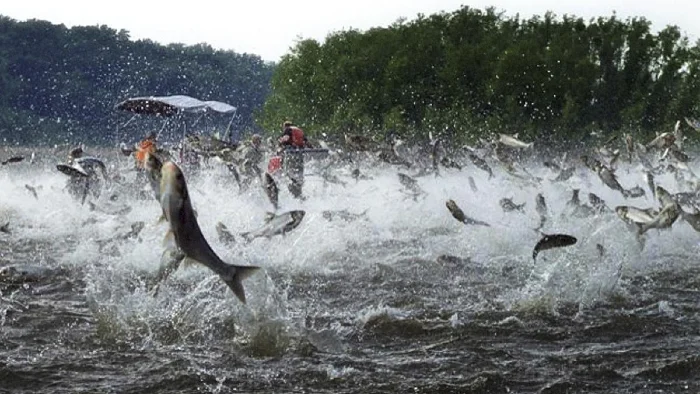The Rising Threat of America’s Most Unwanted Fish
In the tranquil waters of South Dakota, a silent battle is being waged against invasive species threatening native ecosystems. Leading the charge are scientists like South Dakota State University biologist Alison Coulter, pictured holding a silver carp, and her colleagues, who are joining forces with local Game, Fish & Parks officials.
Their focus is the invasive carp, dubbed “America’s most unwanted fish,” due to their damaging impact on local biodiversity.

Once these invasive species establish themselves in a body of water, they dominate the ecosystem, outcompeting and overshadowing native species. The challenge is immense, as fully eradicating these invaders is a Herculean task.
A Scientific and Community-Based Approach
The team’s efforts include modeling potential flood scenarios along the James River, a crucial habitat for carp, and a conduit for their expansion into new areas, including the Missouri River. Their goal is to predict and prevent the spread of carp upstream of the Gavins Point Dam, protecting the native walleye and other species.
Invasive carp, comprising four different species including the prolific bighead and silver carp, pose unique threats.

Bighead carp devour zooplankton, while silver carp feast on phytoplankton, directly competing with native fish for these essential resources. Coulter explains, “First, you see changes in your plankton and zooplankton, which overall can mean less food for your native species. This eventually affects the native fish populations.”

The Unusual Threat of Silver Carp
Silver carp, also known as “flying carp,” are particularly notorious for their ability to leap up to 10 feet into the air, often colliding with unsuspecting boaters and water-skiers. This peculiar behavior, usually triggered by motorboat noise, adds an element of danger to recreational activities on the water.

Grass Carp and Black Carp: Other Invasive Challengers
Grass carp and black carp, the other two invasive species, have their unique impacts. Grass carp feed on aquatic vegetation, crucial for the survival of amphibians, birds, and reptiles. Black carp, on the other hand, consume crayfish and other small aquatic organisms, directly competing with native fish and other wildlife like birds and otters for food.

The Economic and Ecological Stakes
The economic stakes are high, with billions spent on barriers in the Chicago area to prevent these fish from entering the Great Lakes. A successful invasion there could disrupt industries worth billions, including commercial fishing and tourism.
In South Dakota, rising water levels and increased flooding, like the 2011 Missouri River flood, have facilitated the spread of invasive carp. This has led to declines in fisheries and water quality, as seen in Lake Yankton, until a controlled kill was undertaken in 2014.
Human Intervention and Accidental Introductions
Another factor aiding the spread of invasive carp is the live bait trade. Anglers often struggle to differentiate between native and invasive juvenile fish, leading to accidental introductions. Coulter stresses the importance of understanding regulations: “In South Dakota, you are not supposed to catch live bait for yourself at one waterbody and move it somewhere else. Nor are you allowed to release live bait.”

Turning the Tide: Encouraging Consumption and Utilization
While fishing provides a means for these carp to spread, it also offers a method to manage them. Interestingly, invasive carp have a mild taste, like tilapia, unlike the rougher taste of common carp. Coulter encourages their consumption: “They taste pretty good. You are also seeing people developing other products [from them] like fertilizers, dog food, and cut bait.”
Anglers and bow fishers in South Dakota who catch an invasive carp in a new location are urged to report the catch to officials, contributing to the collective effort to manage this ecological threat.
More To Discover
Conclusion: A Community Effort for Environmental Preservation
The fight against invasive carp in South Dakota’s waters is more than a scientific challenge; it’s a call to action for the community. By understanding the threat, respecting regulations, and utilizing these fish as a resource, everyone can play a part in preserving native species and maintaining the delicate balance of our aquatic ecosystems.



















